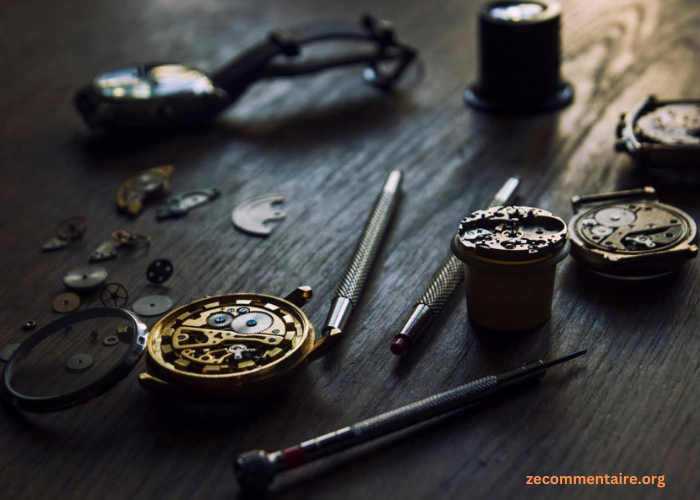Are you fascinated by watches but unsure of how they tick? Imagine a world where every tick, and tock, tells a story. This guide is your gateway to understanding the heart of every timepiece.
Whether you’re a budding collector or a curious onlooker, you’re in for an enlightening journey. Get ready to uncover the secrets behind different watch movement types and their unique functions.
Dive in, and let’s demystify the art of watch movements together. Let’s begin!
Mechanical Movements
Mechanical movements are the heart and soul of traditional watches. There are different types of mechanical movements, but the main ones are:
Manual Hand-Wound Movements
These movements require manual winding using the crown on the side of the watch. The wearer must wind the mainspring every day or every few days, depending on the power reserve of the watch.
Automatic or Self-Winding Movements
Automatic movements use a rotor that turns with the movement of the wearer’s wrist to automatically wind the mainspring. This eliminates the need for manual winding.
Kinetic Movements
Kinetic movements combine both mechanical and quartz technology. They use a weight system that is powered by motion to generate electricity, which is then stored in a battery.
This allows the watch to run without the need for winding or a battery change.
Quartz Movements
Quartz movements are known for their accuracy and low maintenance. These movements use a battery as a power source which sends an electric current to a small piece of quartz crystal.
The quartz vibrates at a precise frequency of 32,768 times per second. These vibrations are measured by a circuit, converting them into a pulse. The pulse drives a small motor, moving the watch’s hands with precision.
Quartz watches are less expensive to produce. They require fewer moving watch parts than mechanical watches which makes them more affordable. They are also incredibly accurate as they can lose or gain only a few seconds per month.
Because of this, they are favored by those who need precise timekeeping. Plus, they are less prone to damage from shock or magnets, making them a durable choice for everyday wear.
Solar Movements
Solar movements are powered by light instead of a battery. They use photovoltaic cells that convert light into electrical energy, which is then stored in a rechargeable cell.
Additionally, solar watches can absorb both natural and artificial light, making them reliable and eco-friendly. They are also very accurate, with some models being able to run for up to six months on a single charge.
However, they may require more maintenance, such as replacing the rechargeable cell every few years.
Spring Drive Movements
Spring drive movements are a unique combination of both mechanical and quartz movements. They use a mainspring but instead of using an escapement to regulate the timekeeping, they use a quartz oscillator.
Time tracking is made easier and more precise as a result. Additionally, they feature a battery reserve indicator that displays the remaining energy in the watch.
With only a few moving parts, they are easy to maintain and are known for their precision.
Chronograph Movements
Chronograph movements are a sophisticated type of watch movement that functions as both a timekeeping device and a stopwatch. The key features of these movements are:
Start, Stop, and Reset Functions
The distinct pushers allow the wearer to start, stop, and reset the chronograph function without interrupting the regular timekeeping.
Sub-dials (Totalizers)
These are small dials on the watch face that measure the elapsed time in specified increments (seconds, minutes, hours). They can have different combinations of sub-dials, such as a 30-minute counter and a 12-hour counter.
Tachymeter Scale
A tachymeter is a type of scale on the watch bezel or dial that allows the wearer to measure speed based on time. This is useful for activities like racing or measuring distance traveled.
These features make them a favorite among enthusiasts for their craftsmanship and stopwatch features. Be it for practical use or as an elegant accessory, chronograph movements epitomize the complex art of watchmaking.
Tourbillon Movements
Tourbillon movements are a marvel of engineering as they counteract the effects of gravity. This is achieved by mounting the escapement and balance wheel in a rotating cage.
The heart of a tourbillon is its rotating cage. Inside are the escapement and balance wheel. As the cage rotates, it averages out positional errors, enhancing the watch’s accuracy.
Additionally, modern tourbillons might have single, double, or even triple axes of rotation. Each added axis further refines accuracy.
Today, they are found in high-end watches and are often showcased as a luxury and status symbol. While modern technology has improved accuracy, tourbillons remain a fascination. They embody the art and history of traditional watchmaking.
Digital Movements
Digital movements mark the evolution of timekeeping into the modern age. They use an electronic display, typically in the form of an LCD or LED.
Simplicity and Accuracy
Digital watches are prized for their simplicity and precision. The time is shown as digits, eliminating the need for moving parts. This results in highly accurate timekeeping.
Low Maintenance
Digital watches require minimal maintenance. They are powered by a battery that can last several years. This contrasts with mechanical and automatic watches that need regular servicing.
Additional Features
Digital watches often come with extra features. These can include alarms, timers, backlighting, and even health-monitoring tools. They provide more than just timekeeping.
Durability
Most digital watches are built to be robust. They can withstand shock, water, and extreme temperatures. This makes them a reliable choice for various activities.
Affordability
Digital watches are generally affordable. This makes them accessible to a broad audience. Despite their low cost, they still offer excellent functionality.
Smart Movements
Smart movements are a new addition to the watch world. They combine traditional watchmaking with cutting-edge technology. They can:
- connect to the internet
- make calls
- send messages
- perform a range of other functions
These watches often come with customizable features such as interchangeable straps or digital watch faces. They cater to different lifestyles and tastes, allowing for personalization.
Plus, they can receive regular software updates, making them a long-term investment.
Exploring Different Watch Movement Types
Understanding the different watch movement types opens a world of appreciation for horology. Whether you’re drawn to the precision of quartz or the elegance of mechanical movements, there’s a perfect watch for everyone.
Ready to find your ideal timepiece? Explore your options today and discover the art of fine watchmaking. Happy timekeeping!
Did you find this article helpful? Check out the rest of our blog now!





